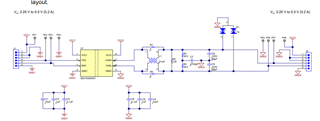newbie_hs
Full Member level 2

I am using ISO1042 in my design. My can bus voltage can go up to 70V.
I checked the reference design provided by TI .The ESD diode(CDSOT23-SM712) specified by TI can stand a reverse voltage of 12V (Max).
I checked for other ESD diodes which can with stand a reverse voltage more than 70V.I am not able to see an ESD diode with standoff of 70V.
The maximum clamping voltage allowed is 70V

May I know is there any other method to protect the CAN bus from high voltage.
I checked the reference design provided by TI .The ESD diode(CDSOT23-SM712) specified by TI can stand a reverse voltage of 12V (Max).
I checked for other ESD diodes which can with stand a reverse voltage more than 70V.I am not able to see an ESD diode with standoff of 70V.
The maximum clamping voltage allowed is 70V

May I know is there any other method to protect the CAN bus from high voltage.


